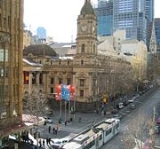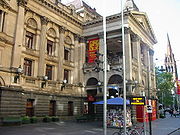
Melbourne Town Hall
Encyclopedia
Melbourne Town Hall is the central municipal building
of the City
of Melbourne
, Australia
, in the State
of Victoria
. It is located on the northeast corner of Swanston
and Collins
Streets, in the central business district. It is the seat of the Local Government Area of the City of Melbourne
. It has been used for multiple purposes such as theatrical plays, exhibitions as well as school concerts.
on December 13, 1842, with Henry Condell as its first Mayor
. However, it wasn't until 1854 that its first Town Hall was completed. Begun in 1851, the work ground to a halt with the beginning of the Victorian gold rush
. The foundation stone of a new, grander Town Hall was laid on November 29, 1867 by the visiting Prince Alfred, Duke of Edinburgh, after the demolition of the first. The current Town Hall officially opened on August 9, 1870 with a lavish ball
, which was personally funded by the Lord Mayor Samuel Amess
.
The foundation stone of the additional front portico
was laid in 1887, and Sir Henry Weedon laid the foundation of the administrative annex building in 1900.
In 1925, a fire destroyed a large part of the town hall, including the main auditorium and pipe organ
. It was rebuilt and enlarged, extending east over the site previously occupied by the Victoria Coffee Palace, an early temperance hotel frequented by Melbourne's power brokers. The rebuilt section lost some of Reed's original flourishes including the elaborate mansard roof.
Joseph Reed
, in the Second Empire style. Reed's designs also included the State Library of Victoria
, the Royal Exhibition Building
, and Melbourne Trades Hall.
The building is topped by Prince Alfred's Tower, named after the Duke
. The tower includes a 2.44 m diameter clock
, which was started on August 31, 1874, after being presented to the council by the Mayor's son, Vallange Condell. It was built by Smith and Sons of London. The longest of its copper
hands measures 1.19 m long, and weighs 8.85 kg
.
The Main Auditorium includes a magnificent concert organ, now comprising 147 ranks and 9,568 pipes. The organ was originally built by Hill, Norman & Beard (of England) in 1929 and was recently rebuilt and enlarged by Schantz Organ Company of the United States of America .

37.815145°N 144.9667776°W
Municipal Building
Municipal Building may refer to:*A city or town hall*Places named "Municipal Building":in the United States:*Municipal Building , El Dorado, AR, listed on the National Register of Historic Places in Arkansas...
of the City
City
A city is a relatively large and permanent settlement. Although there is no agreement on how a city is distinguished from a town within general English language meanings, many cities have a particular administrative, legal, or historical status based on local law.For example, in the U.S...
of Melbourne
Melbourne
Melbourne is the capital and most populous city in the state of Victoria, and the second most populous city in Australia. The Melbourne City Centre is the hub of the greater metropolitan area and the Census statistical division—of which "Melbourne" is the common name. As of June 2009, the greater...
, Australia
Australia
Australia , officially the Commonwealth of Australia, is a country in the Southern Hemisphere comprising the mainland of the Australian continent, the island of Tasmania, and numerous smaller islands in the Indian and Pacific Oceans. It is the world's sixth-largest country by total area...
, in the State
States and territories of Australia
The Commonwealth of Australia is a union of six states and various territories. The Australian mainland is made up of five states and three territories, with the sixth state of Tasmania being made up of islands. In addition there are six island territories, known as external territories, and a...
of Victoria
Victoria (Australia)
Victoria is the second most populous state in Australia. Geographically the smallest mainland state, Victoria is bordered by New South Wales, South Australia, and Tasmania on Boundary Islet to the north, west and south respectively....
. It is located on the northeast corner of Swanston
Swanston Street, Melbourne
Swanston Street is a major thoroughfare in the centre of Melbourne, Australia. It is historically one of the main streets of central Melbourne, laid out in 1837 as part of the Hoddle Grid, the layout of major streets that makes up the central business district...
and Collins
Collins Street, Melbourne
Collins Street is a major street in the Melbourne central business district and runs approximately east to west.It is notable as Melbourne's traditional main street and best known street, is often regarded as Australia's premier street, with some of the country's finest Victorian era buildings.The...
Streets, in the central business district. It is the seat of the Local Government Area of the City of Melbourne
City of Melbourne
The City of Melbourne is a Local Government Area in Victoria, Australia, located in the central city area of Melbourne. The city has an area of 36 square kilometres and has an estimated population of 93,105 people. The city's motto is "Vires acquirit eundo" which means "She gathers strength as she...
. It has been used for multiple purposes such as theatrical plays, exhibitions as well as school concerts.
History
Melbourne was officially incorporated as a townTown
A town is a human settlement larger than a village but smaller than a city. The size a settlement must be in order to be called a "town" varies considerably in different parts of the world, so that, for example, many American "small towns" seem to British people to be no more than villages, while...
on December 13, 1842, with Henry Condell as its first Mayor
Mayor
In many countries, a Mayor is the highest ranking officer in the municipal government of a town or a large urban city....
. However, it wasn't until 1854 that its first Town Hall was completed. Begun in 1851, the work ground to a halt with the beginning of the Victorian gold rush
Victorian gold rush
The Victorian gold rush was a period in the history of Victoria, Australia approximately between 1851 and the late 1860s. In 10 years the Australian population nearly tripled.- Overview :During this era Victoria dominated the world's gold output...
. The foundation stone of a new, grander Town Hall was laid on November 29, 1867 by the visiting Prince Alfred, Duke of Edinburgh, after the demolition of the first. The current Town Hall officially opened on August 9, 1870 with a lavish ball
Ballroom dance
Ballroom dance refers to a set of partner dances, which are enjoyed both socially and competitively around the world. Because of its performance and entertainment aspects, ballroom dance is also widely enjoyed on stage, film, and television....
, which was personally funded by the Lord Mayor Samuel Amess
Samuel Amess
Samuel Amess was Mayor of Melbourne from 1869–1870, after having joined the council in 1864. Born in Newburgh, Fife in Scotland, Amess immigrated to Victoria in 1852, and after success on the goldfields established himself as a building contractor...
.
The foundation stone of the additional front portico
Portico
A portico is a porch leading to the entrance of a building, or extended as a colonnade, with a roof structure over a walkway, supported by columns or enclosed by walls...
was laid in 1887, and Sir Henry Weedon laid the foundation of the administrative annex building in 1900.
In 1925, a fire destroyed a large part of the town hall, including the main auditorium and pipe organ
Pipe organ
The pipe organ is a musical instrument that produces sound by driving pressurized air through pipes selected via a keyboard. Because each organ pipe produces a single pitch, the pipes are provided in sets called ranks, each of which has a common timbre and volume throughout the keyboard compass...
. It was rebuilt and enlarged, extending east over the site previously occupied by the Victoria Coffee Palace, an early temperance hotel frequented by Melbourne's power brokers. The rebuilt section lost some of Reed's original flourishes including the elaborate mansard roof.
Architecture
The Town Hall was designed by the famous local architectArchitect
An architect is a person trained in the planning, design and oversight of the construction of buildings. To practice architecture means to offer or render services in connection with the design and construction of a building, or group of buildings and the space within the site surrounding the...
Joseph Reed
Joseph Reed (architect)
Joseph Reed , a Cornishman by birth, was probably the most influential Victorian era architect in Melbourne, Australia. He established a practice, Reed and Barnes in Melbourne in 1852. The practice now known as Bates Smart is one of the oldest continually operating in the world.Reed's buildings...
, in the Second Empire style. Reed's designs also included the State Library of Victoria
State Library of Victoria
The State Library of Victoria is the central library of the state of Victoria, Australia, located in Melbourne. It is on the block bounded by Swanston, La Trobe, Russell, and Little Lonsdale streets, in the northern centre of the central business district...
, the Royal Exhibition Building
Royal Exhibition Building
The Royal Exhibition Building is a World Heritage Site-listed building in Melbourne, Australia, completed in 1880. It is located at 9 Nicholson Street in the Carlton Gardens, flanked by Victoria, Nicholson, Carlton and Rathdowne Streets, at the north-eastern edge of the central business district...
, and Melbourne Trades Hall.
The building is topped by Prince Alfred's Tower, named after the Duke
Duke
A duke or duchess is a member of the nobility, historically of highest rank below the monarch, and historically controlling a duchy...
. The tower includes a 2.44 m diameter clock
Clock
A clock is an instrument used to indicate, keep, and co-ordinate time. The word clock is derived ultimately from the Celtic words clagan and clocca meaning "bell". A silent instrument missing such a mechanism has traditionally been known as a timepiece...
, which was started on August 31, 1874, after being presented to the council by the Mayor's son, Vallange Condell. It was built by Smith and Sons of London. The longest of its copper
Copper
Copper is a chemical element with the symbol Cu and atomic number 29. It is a ductile metal with very high thermal and electrical conductivity. Pure copper is soft and malleable; an exposed surface has a reddish-orange tarnish...
hands measures 1.19 m long, and weighs 8.85 kg
Kilogram
The kilogram or kilogramme , also known as the kilo, is the base unit of mass in the International System of Units and is defined as being equal to the mass of the International Prototype Kilogram , which is almost exactly equal to the mass of one liter of water...
.
The Main Auditorium includes a magnificent concert organ, now comprising 147 ranks and 9,568 pipes. The organ was originally built by Hill, Norman & Beard (of England) in 1929 and was recently rebuilt and enlarged by Schantz Organ Company of the United States of America .
Tourism

External links
- City of Melbourne official website
- Disability information
- http://www.schantzorgan.com/ArchiveDetail.cfm?yJob=2161
37.815145°N 144.9667776°W

